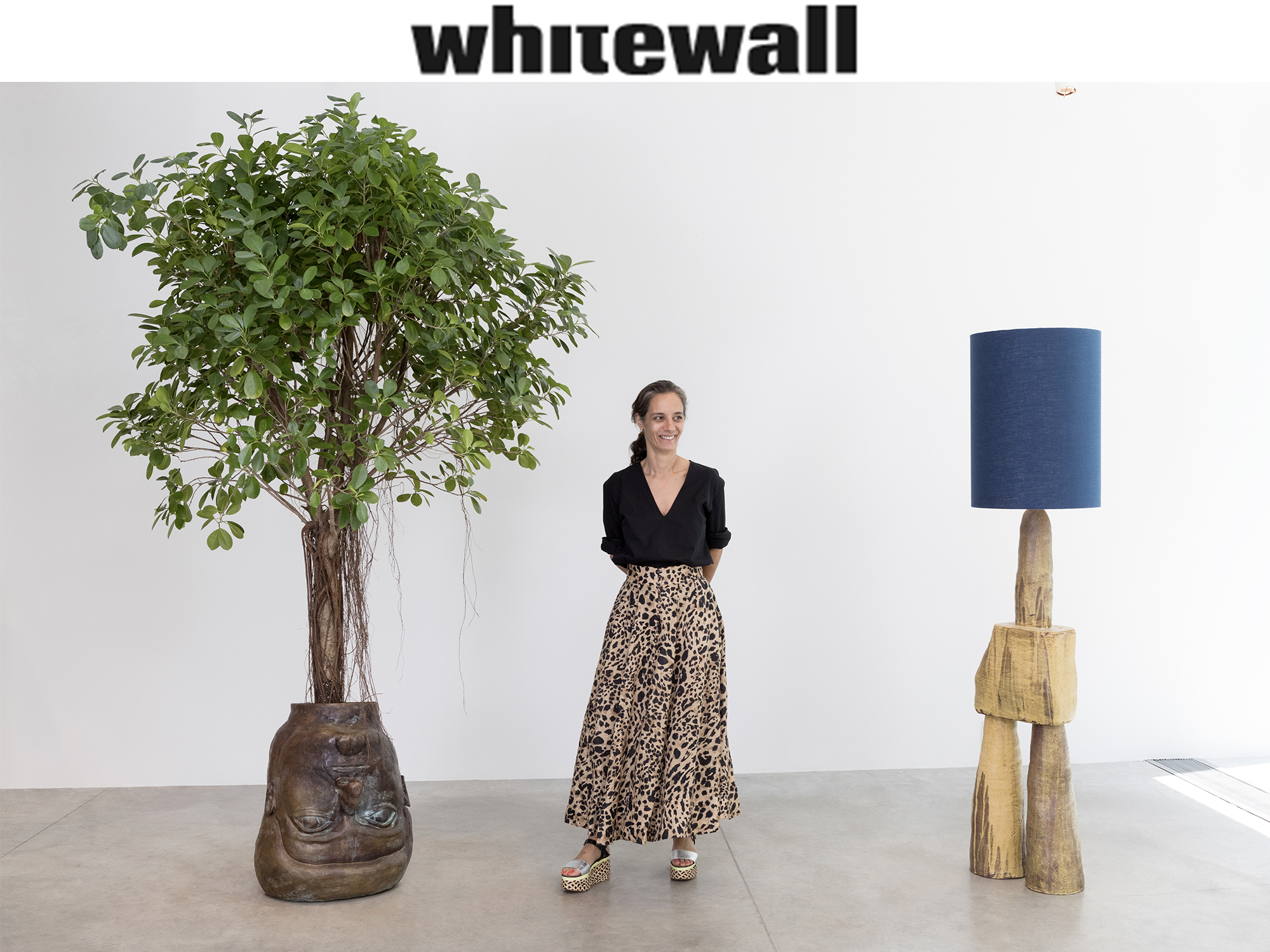Carmen D’Apollonio’s “Don’t Wake the Snake” was on view at Friedman Benda gallery in New York from July 15 to August 13, 2021. The show represented the culmination of the Los Angeles–based artist’s creative practice in clay, a self-taught journey she began less than ten years ago. Using a coiling technique, she creates objects, vessels, and lighting pieces in familiar and figurative shapes, as well as organically delightful forms that ignite the imagination.
Her pieces are full of personality and a charming peculiarity. Two seated shapes interlock elbows topped with matching lampshades. An upside-down oversized head serves as a large planter for a tree. Folds of crimson-glazed clay build toward an asymmetric burgundy shade.
Whitewall spoke with D’Apollonio by phone over the summer, just as her works were being shipped to New York. From her studio, she told us how each work leads to the next, allowing herself to stay interested, experimental, and never bored. She shared her thoughts about her recent exploration of bronze, a wider array of colors, and new shapes.
WHITEWALL: How did you arrive at the title of the show, “Don’t Wake the Snake”?
CARMEN D’APPOLLONIO: One piece is called Don’t Wake the Snake, and I thought it was a fun title. I also have some work that looks snake-y, so I think it fits really well with my work.
I started with one piece, and one piece became another, and then from this piece I went to another. It happened totally naturally. I had in mind to make five or seven figurative pieces, and after two I got a little bored. So I did something else. The good thing about doing what I do is that I can do whatever. There is no barrier. It’s free.
WW: The exhibition includes some examples of your first work in bronze. What was it like working that way?
CDA: Bronze is much easier for me because I don’t have to fire the piece. I don’t have to go through all this process of drying and firing the first time, and then fire glazing, and then if it cracks. Working on the show, we decided to make some of my pieces in bronze. It’s super exciting for me. It’s the first time I did work in bronze and I’m super happy about it.
WW: You’ve said that you like when your sculptures have a function. And you work a lot with adding elements of lighting. What do you enjoy about that?
CDA: I started to do lighting because I needed some lamps for my home. And then I realized that I can do whatever, put a lampshade on it, and it’s always going to be a light source. I usually start something not because I think about a lamp, but I concentrate on a base. When I started to do bronze, I also started to work on the shade in a different, way so it’s not always the drum shade. It’s a different way I experience doing lighting, integrating the shape more to the base.
I started to experiment with different materials. I started to experiment more with colorful glazes. There is a lot of yellow, blue, turquoise. I went completely crazy with the glazes. And because I got my own kiln, about a year ago, I started to do everything in-house and experience what can happen when you mix two glazes. And I really like it.
WW: With your own kiln, can you experiment more?
CDA: Yes, it’s different when you can experience it in your own studio. You can make a mess and you’re freer to mess around.
WW: What is your studio in Los Angeles like?
CDA: I wake up very early, I go walk my dog, and then I go to the studio. I’m at the studio between seven and eight. I make a coffee, smoke a cigarette, and then I just start. Sometimes I do little models, sometimes I have some ideas in my head then I just try to make mockups out of the idea, and then I take the clay and I start.
WW: Prior to starting your own practice, you worked in other creative fields and with Urs Fischer for many years. We read that you took your first ceramics class in Switzerland. What about clay clicked for you?
CDA: I always wanted to. I did a lot of sculpture work for Urs, but we never used clay. A friend told me about this ceramic workshop, so I started there. And I was like, “Okay, that’s it.” It’s so much fun and I love the material. When I moved to L.A., I started to go to these different ceramic workshops. I tried the wheel but it didn’t go so well, and I decided, “I’m going to do it all by hand.” I had my first small studio, and people started to see my work. And then I got in more and more.
WW: After working on a big project like this show, what comes next?
CDA: When everything is out, I’m going to clean out the studio, and then I’m going to start with new pieces.










